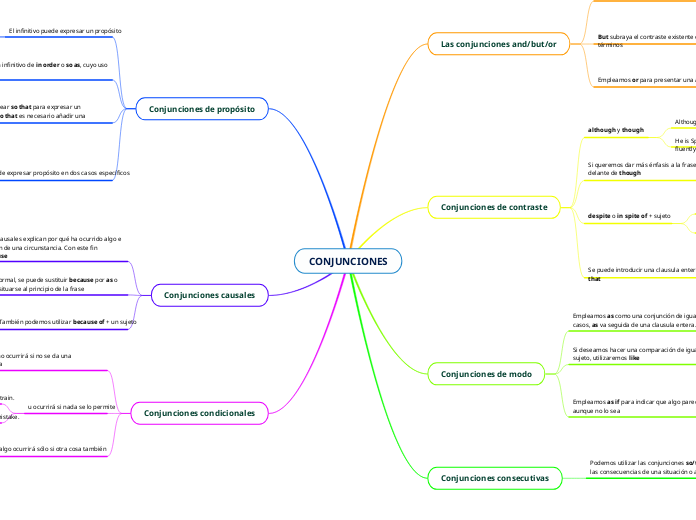CONJUNCIONES
Las conjunciones and/but/or
And une o enlaza dos cláusulas o dos términos separados
I went to the lake and I went to the river
She bought a pair of trousers and a jacket
But subraya el contraste existente entre dos clausulas o dos términos
He's not really intelligent, but he's very attractive.
We are poor, but happy.
Empleamos or para presentar una alternativa o posibilidad
We can go by train or we can go by bus.
You can have chicken or steak.
Conjunciones de contraste
although y though
Although she had been working all night she wasn't tired.
He is Spanish, though he can speak English and German fluently.
Si queremos dar más énfasis a la frase, podemos añadir even delante de though
even though she hasn't really revised enough she's going to do the exam.
Just keep saying 'yes', even though you don't understand.
despite o in spite of + sujeto
He finished off the cake in spite of his diet.
Despite their difference in age they decided to get married.
Se puede introducir una clausula entera si añadimos the fact that
In spite of the fact that she had three alarm clocks she still didn't get up in time
Despite the fact that he had been on a do-it-yourself course he couldn't fix the cupboard.
Conjunciones de modo
Empleamos as como una conjunción de igualdad. En estos casos, as va seguida de una clausula entera.
He's an excellent cook, as his mother used to be.
Si deseamos hacer una comparación de igualdad con un sujeto, utilizaremos like
He looks a bit like a rock star from the seventies.
She's like a Greek goddess.
Empleamos as if para indicar que algo parece ser verdad aunque no lo sea
She looks as if she's been awake all night.
They look as if they've come from a fancy dress party.
He acts as if he is the boss.
Conjunciones consecutivas
Podemos utilizar las conjunciones so/that's why para explicar las consecuencias de una situación o acción
It was freezing cold so we went inside.
He thought it was going to rain, that's why he's got an umbrella with him.
Conjunciones de propósito
El infinitivo puede expresar un propósito
He closed the door to keep warm
She ran home to be in time for the match
Podemos acompañar un infinitivo de in order o so as, cuyo uso es opcional
She left early (in order) to catch the last bus.
They are coming tomorrow (so as) to prepare for the conference.
También podemos emplear so that para expresar un propósito. Después de so that es necesario añadir una cláusula entera
She opened the door so that the cat could come in
For puede expresar propósito en dos casos específicos
for + sujeto para dar a conocer un objetivo
We went out for a drink
They will go for a run
for + verbo en _ing para describir la utilidad de un objeto
A hammer is for hitting nails.
A toothbrush is for cleaning your teeth.
Conjunciones causales
Las conjunciones causales explican por qué ha ocurrido algo e introducen la razón de una circunstancia. Con este fin empleamos because
We went to buy some cheese because we were going to make a pizza.
En un inglés más formal, se puede sustituir because por as o since, que suelen situarse al principio de la frase
As it was raining we didn't go out.
Since there's no time left we'll have to postpone it.
También podemos utilizar because of + un sujeto
The match was cancelled because of the heavy rain.
Conjunciones condicionales
Unless sugiere que algo no ocurrirá si no se da una determinada circunstancia
I won't go unless she pays.
She won't tidy her room unless you help her.
u ocurrirá si nada se lo permite
They'll be here at six, unless they miss the train.
He'll pass all his exams unless he makes a stupid mistake.
As long as nos dice que algo ocurrirá sólo si otra cosa también ocurre
I'll tell you as long as you promise not to tell anyone else.
She'll come as long as she thinks John is going to be there.
